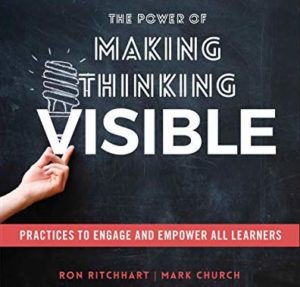

Ritchhart and Church make a compelling case that teaching with a focus on making thinking visible can transform students’ learning experience by giving them more agency and thus greater feelings of engagement, deepening their understanding (measured in both standard and non-standard ways), enhancing formative assessment, and ultimately supporting their intellectual character so that they will be lifelong learners, prepared for all they will encounter beyond school.
There are many tools that teachers can use to make thinking visible, and part of teachers’ and students’ task is to develop skill in understanding which thinking tools are appropriate for a given context. The authors focus on 18 routines for making thinking visible. They explain the purpose of the routine, the contexts in which it is appropriate to use the routine, steps to implementation and possible variations, and how to assess students’ use of the thinking routine. They also offer compelling and informative examples of the use of the routine in diverse classroom settings. Routines are aimed at increasing questioning, noticing, empathic listening, perspective taking, observing, documenting, and planning. Some routines seek to support students in reasoning with evidence, synthesizing, reflecting, identifying core concepts, considering possibilities, exchanging ideas, receiving feedback, and appreciating truth and beauty.
It is possible to make thinking visible across all academic subjects and domains. Advancing students’ thinking skills in a domain can help students master curricular content more efficiently.
Especially with the examples and instructions provided in this book it can be easy to implement these thinking routines, but doing so well can remain a challenge. Teachers benefit from developing an understanding of when and where deep thinking is needed, noticing it as it emerges, cultivating students’ thinking when they are doing it, and reflecting on how to embed more deep thinking opportunities into the learning experiences of students. Teachers who are skilled at supporting thinking set long-term learning goals for students, listen and respond to students, remain flexible, set high expectations, and believe in the transformative power of teaching thinking skills. Focusing too much on a short-term daily agenda or scheduling class time too densely can be counterproductive. Given the difficulty associated with teaching to make thinking visible and the fact that teachers’ own growth and development as educators takes time and experience, it is important for educators to support one another in the process of making thinking visible. Ritchhart and Church suggest ways to facilitate teachers in supporting one another in developing this skill.
The Power of Making Thinking Visible is an extremely practical, usable guide for educators to support students in honing sharp minds. To learn more about supporting the process of thinking, see Creating Cultures of Thinking, also by Ron Ritcchart.
Ritchhart, R., & Church, M. (2020). The power of making thinking visible: practices to engage and empower all learners. John Wiley & Sons.




